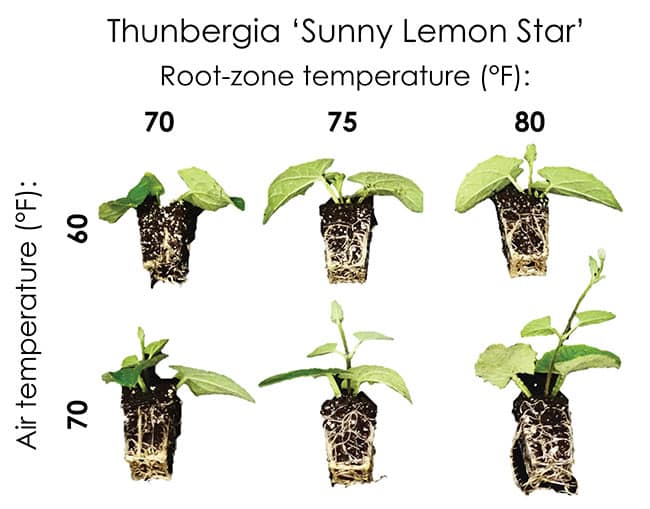Technically Speaking: Several Consequences of Growing Too Cool
An increase in natural gas exports, geopolitical events and strong demand have led to a considerable increase in fuel prices in the last two years. Unfortunately, this has made it substantially more expensive to heat greenhouses. Energy consumption for heating depends on several factors; obviously, one of them is the greenhouse temperature setpoint. To decrease energy costs, it is tempting to lower heating settings, but this has several consequences to the crops growing inside.
Slower rooting during propagation. Whether you are rooting cuttings or growing seedlings, root development is primarily determined by the temperature of the root zone and the daily light integral (DLI). The air temperature can also influence rooting; active shoot growth typically promotes root growth. Therefore, maintaining both desirable air and root-zone temperatures, as well as delivering sufficient light (at least once root initials have formed), generally leads to the quickest production of plugs and liners.

Recommended air and rootzone temperatures can depend on the crop and, in some cases, the average DLI. In the absence of crop-specific information, a root-zone temperature of 73 to 77° F and a slightly cooler air temperature are recommended. However, there are some crops that root faster at a higher air temperature, particularly those that are cold sensitive. For example, rooting of the cold-sensitive crop thunbergia was much more rapid at an air temperature of 70° F than at 60° F, regardless of the root-zone heating temperature (Figure 1).
Longer crop production time. The rate of plant development increases linearly with temperature, until some crop-specific maximum value. Thus, it takes longer for a plant to become marketable — such as to fill its container or to flower — as the average daily temperature is decreased. The magnitude of the delay depends on the crop, and is much greater for cold-sensitive crops such as celosia, thunbergia, and vinca than for cold-tolerant crops such as osteospermum, snapdragon, and marigold.
Although counter-intuitive, in some situations lowering the temperature can actually increase heating costs on a per-crop basis. Over the years, we have done many heating cost simulations using the Virtual Grower computer software developed by the USDA-ARS. We estimated time to flower and heating costs to produce various bedding plant crops at different temperatures in different locations in the U.S. during different times of the year. For northern locations and early spring production (flowering in March), the heating cost per crop decreased for all species as temperatures increased. For more southern locations and early spring production, the heating cost per crop decreased as temperature increased, but only for cold-sensitive crops. For cold-sensitive and cold-intermediate crops, as well as for later spring production, heating costs per crop were less sensitive to temperature and crop time.
Higher humidity. The amount of water that air can hold decreases with temperature. Therefore, lowering the temperature usually translates into an increase in humidity and decrease in the vapor-pressure deficit (VPD). Except during propagation, a recommended minimum VPD is 0.7 kPa, which corresponds to a maximum relative humidity of 64% at 63° F, 70% at 68° F and 75% at 73° F. When the VPD is lower (relatively humidity is higher), crop uptake of water and nutrients typically decrease and some plant pathogens spread more easily.
To conclude, lowering the greenhouse temperature is usually not recommended when propagating plants, or when finishing cold-sensitive crops, especially for growers in cold climates. A decrease in air temperature usually leads to higher humidity because cooler air holds less water vapor. Finally, a lower temperature usually translates into less ventilation, which can lead to a deficiency in carbon dioxide (CO2) concentration. A CO2 deficiency greatly decreases crop growth, leading to lower crop quality and possibly a delay in flowering.
For an enhanced reading experience, view this article in our digital edition by clicking here.









 Video Library
Video Library 


















